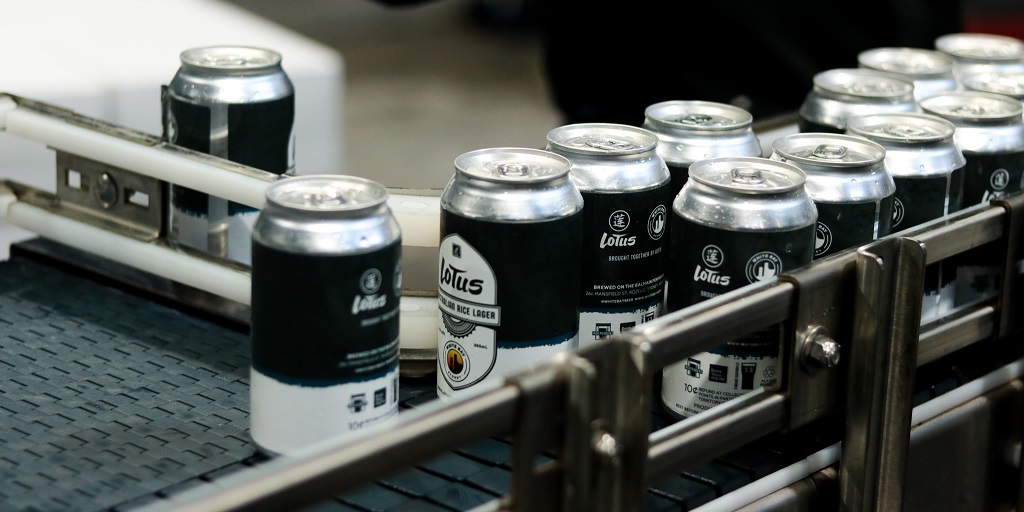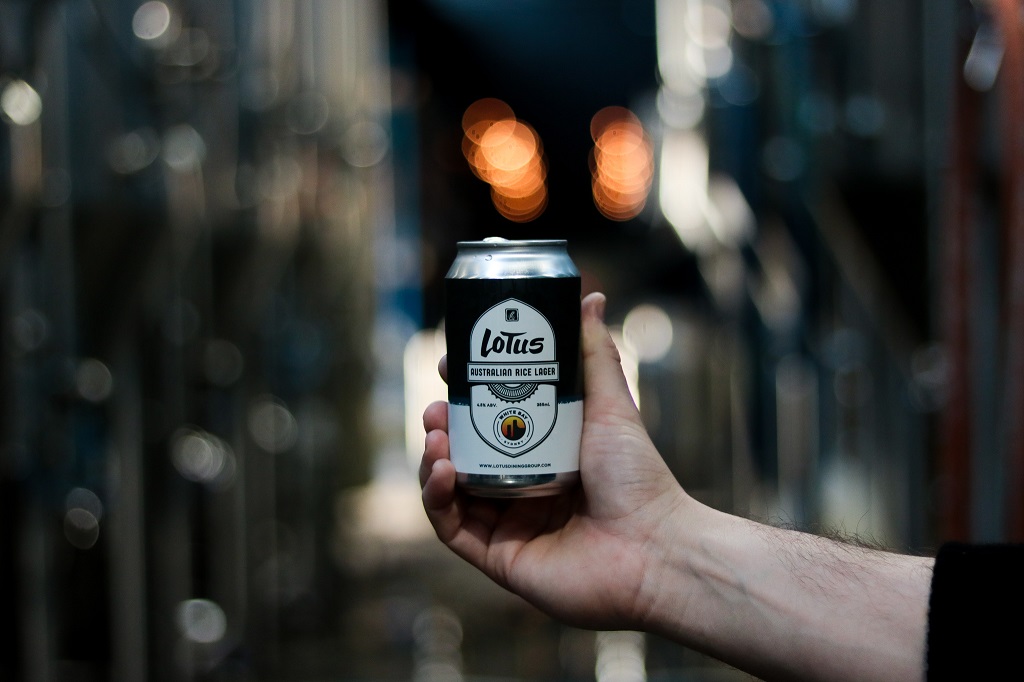
The rise of rice in craft

White Bay Beer Co. has launched a rice lager in partnership with a restaurant group as craft brewers increasingly take on areas that have previously been dominated by major brewers.
Lagers can be a difficult style at the best of times, laying bare any faults in the brewing process. Adding rice as an adjunct has been a controversial topic in craft beer globally for well over a decade as it was seen as the province of major brewers and brands to “water down” beer with a “cheaper” replacement for malted barley.
Rice is no longer considered as cheap as it once was and like US brewers, Australian craft brewers have been taking on Japanese or rice lagers in recent years.
Most recently White Bay in Sydney has launched its White Bay Lotus Australian Rice Lager, designed to pair with restaurant group Lotus Dining’s contemporary Asian cuisine.
“We initially were talking with them about getting our core range in and they came back and said we have this idea to make a beer to suit our cuisine,” explained White Bay’s head brewer Dennis de Boer.
“We love lager but brewing a rice lager at that point in time for us as a business we wouldn’t pursue it and didn’t plan to make and sell on our own. It’s the partnership Lotus that has helped and they are helping to support the project.”
Taking over from the majors
Craft brewers are increasingly taking over spaces once solely the province of major brewers, from sport sponsorships and festivals to nitro beers, and the latest takeover appears to be in the rice and light lager style.
Considered a cheap adjunct compared to malted barley, rice has been criticised in the past by craft brewers as an attempt by major brewers and brands like Budweiser to cut costs rather than create good beer, but also create a less challenging style which appealled to a wider range of mainstream audiences – the traditional demographics for so-called ‘macrolagers’, be they made with barley or rice.
“Rice in particular is a good filler for gigantic macro lager,” said de Boer. ”But I do think, as with anything else, that just because it’s used there doesn’t make it bad, it’s an ingredient that can make good beer and it’s worth exploration.”
Like many rice lagers Lotus is made with approximately 20 per cent rice.
“It’s our first time using it in a lager, we use it in some of our speciality beers, as rice adds a cool sweetness element to it you can’t get from any other cereal, a bit of an apple, pear, sake flavour combination.
“The big challenge when we started brewing this was the really apple peary sweetness that rice contributed to the beer, we wanted to make sure we could balance that out.
“So for us it was choosing the right hop additions, this beer got a bit bigger bittering and kettling charge to it, to offset that sweet flavour from the rice
“We used a pretty cool hop called Calista we used in the whirlpool which gives off a tropical vibe as well, so it’s a neat little beer to drink. But I think if we had our time again we would make it a bit more bitter.”
Craft brewers and rice lager
Heads of Noosa Brewing Company launched with what is considered to be one of the first core range craft Japanese Lager made with rice in the craft beer sector. This has been followed by fellow Sunshine Coast brewery Land & Sea Brewing Co. with its 4.4% abv Japanese Rice Lager, Two Birds Brewing with its 5.1% abv Rice Rice Baby, and Yulli’s Brews’ Karaoke Kingu Rice Lager.
The idea for Heads of Noosa’s Japanese Lager had been in the making for a long while, explained Masterton, in their early days of homebrewing in 2010.
“It was one of those beers we developed over time with others in the shed,” he said.
“With all our brews we do a step mash of some form or another, and for a good lager it really comes down to a good fermentation and not rushing. It’s also filtered which takes all the yeast out of it, and gives you a beautiful looking beer in a glass.
“It’s also worth mentioning having a good quality brewhouse and having those touch points so you can control those things that have potential to change.”
Tom Davies, head brewer at Yulli’s, said there was a combination of reasons behind launching its version of the rice lager, Karaoke Kingu.
“There’s always been a market for a Japanese lager and indie or craft [brewers] have only recently found pull through with that market.
“The second thing for us is that we’ve found rice imparts a great flavour in the beer for us.
“Most Japanese rice lagers use brown rice syrup or something similar just to dry it out. We use rolled rice that gives a very particular mouth feel on the pallet that’s hard to describe but very moorish.”
Yulli’s launched Karaoke Kingu in April 2020, in collaboration with Audio Technica and it was meant to be a one off beer.
“But it did so well in trade that we made it core range and now it’s our third biggest mover!”
When it comes to initial market positioning and price points it gets tricky, and craft brewers will inevitably need to charge more than a case of Budweiser, coming in at $48.95 for a 24 carton.
While it is a limited run, Lotus will be sold at $82.00 a carton. Meanwhile, acarton of Heads of Noosa’s Japanese Lager costs $73.99 on its site, whilst Yulli’s Karaoke Kingu comes in at $64.00. Yulli’s Davies said this was actually sold at more of a premium than it’s core beers, so it seems that customers are happy to pay more for the craft element of the beer rather than the style.
Each brewery seems to have had different motivations for trying a rice lager out.
White Bay’s De Boer said that while they were aware that they weren’t on the forefront of the trend, they had other reasons for brewing the beer now.
“The follow-through to come from it is more about the partnership with the venue rather than the beer itself.
“I imagine a group like that with buying strength gone to importers and that they would have bent over backwards for them so for them to go with us
De Boer said that Heads of Noosa’s beer had inspired the White Bay version, which is fermented for five weeks under pressure.
“They have their own lager-centric brewery and spared no expense and it shows, theirs has been my benchmark beer in Australia [for this style].”
In fact, Heads of Noosa Japanese Lager has proven so popular it now contributes to between 60 and 65 per cent of its sales, and it’s the broad appeal that has helped the style, explained Craig Masterton, founder of the Sunshine Coast brewery.
“Big beer brands tend to go for a pilsner and a lager because they are more broadly appealing. And for us it’s the climate too, which is why we wanted to nail something like that in Queensland, it’s not overpowering, they are more subtle.”
It is also very different from the hop-driven beers, or those with lots of fruit or other additives.
“It’s like the more hops you can throw at it the easiest it is to hide things in it,” said Masterton.
Masterton said that there has definitely been a reputation associated with the style but it’s a good sign that more craft brewers are taking it on.
“I think it’s fantastic, big brewers have given lagers a dirty name, you ask people and they say it’s a cheap addition.
“The big brewers do have all the bells whistles and controls, but you hear rumours about how they get them out and it’s quicker than how craft brewers get ales out.
“[As a style] it has been tarnished because people look at it as cheap nasty beer and while I can’t speak for the whole industry, craft brewers like us, we don’t take shortcuts.
“We do things the traditional way and take our time.”






